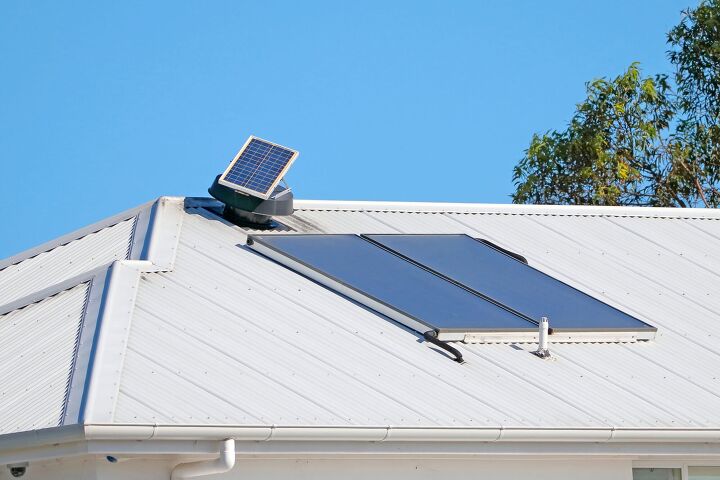What Are The Pros And Cons Of Solar Roof Vents?

Keeping your home cool, especially during the summer months, is crucial. When people usually think of comfort during hot summer days and nights, they usually think of having the air conditioning going at full blast. However, the reality of the situation is that proper roof ventilation can do more for comfort than air conditioning.
A properly ventilated attic space means that excess heat is removed and your utility bills are lowered. When your attic gets too hot, it causes your air conditioning to work harder than it should and leads to higher utility bills. Roof vents, particularly powered ones, use a powerful fan that is controlled by a thermostat. Once the thermostat detects a buildup of heat and humidity in your attic, it kicks on the fan and removes the stale air via the vent.
These types of roof vents are available as hard-wired models that connect to your home’s electrical grid. Alternatively, you can opt for the more efficient solar roof vent option that works off of an integrated solar panel. Aside from being more energy-efficient, solar roof vents are usually easier to install and don’t require the assistance of an electrician. On the downside, these vents aren’t as powerful as their hard-wired counterparts, are more expensive, and the fan may stop spinning when it loses contact with direct sunlight.
With that said, let’s take a deeper look at the pros and cons of solar roof vents and why you might want to consider these types of vents over the alternative.
Do You Need Ducts or Vents Installation or Replacement?
Get free, zero-commitment quotes from pro contractors near you.

Pros of Solar Roof Vents
1. Operates on renewable energy
The most substantial benefit of opting for a solar roof vent is the fact that it operates on renewable energy from the sun rather than being connected to your home’s electrical grid. When you compare the upfront costs associated with purchasing a solar roof vent against the ongoing bills that you would have to pay to operate a hard-wired unit, you’ll come out ahead each time. As an added bonus and an additional way of helping the environment, you’ll also be reducing the carbon footprint of your property.
2. Enhances your home’s energy efficiency
Removing the hot air from your attic during the summer months means that you’ll enjoy more usable, safe storage space for your belongings. This air can also be pushed back into your home during the winter for more efficient heating. In general, a cooler attic space contributes to a lower energy demand throughout the rest of your house. As a result, you can expect to see substantial reductions in both your cooling and heating bills year-round. Meanwhile, by freeing up storage space you’re limiting the clutter in the rest of your home.
3. Improved curb appeal
In most cases, solar roof vents have a lower profile than other ventilation options. This creates a more streamlined appearance and avoids having to use a bulky ventilation fan that can distract from the appeal of your home’s exterior. Not to mention, the environmental consciousness that these units bring may be very appealing to potential buyers when the time comes to sell your home.
The main reason that solar roof vents have a sleeker look is that they typically do not require caulk, roofing cement, or some other product to prevent leaking. Installation is as simple as cutting a hole in the roof (two if you purchase multiple fans). So long as the housings are properly flashed, your solar roof vent can actually improve the curb appeal of your property.
4. Electrician is not needed
Since you need the assistance of an electrician, the cost of connecting a traditional power vent to your electrical grid can add several hundred dollars to the installation process. Fortunately, you can avoid the additional costs by opting for a solar roof vent. Although it may not be powerful enough to remove all of the hot air from your attic, it will create a cooler environment while avoiding a significant installation expense.
5. Quieter operation
In general, solar-powered roof vents are much quieter to operate than conventional models that are powered by electricity. You can put solar roof vents on metal roofs just like you can put solar panels on a metal roof.
6. Access to energy when needed most
When you have inclement weather and overcast skies blocking the sun, less energy is directed into your home. This means that you don’t need to run your roof vent fan on these days to help maintain optimal temperatures. Since solar roof vents take energy from the sun to operate, you’ll be able to run the unit on days that you need it the most without worrying about any additional electrical expense. On the hottest days of the year, the extra sunshine will provide even more power to the unit.
This advantage makes solar roof vents a great investment for any location that experiences over 250 days of sunshine every year. In some areas, it may even reduce your need for air conditioning entirely.
7. Solar power is safer
The effectiveness and safety of attic ventilation fans are often up for debate. However, those that are connected to your electrical grid typically cost more to operate than they can produce savings in the summer months. These models also create zones of negative pressure that may pull air conditioning cooled air into your attic.
The concern here is that they could also pull carbon monoxide and other combustion gases from your appliances upward, creating a potential danger in your attic. These dangers, however, are not present with solar-powered roof vents. Make sure to protect your solar panels from hail.
Cons of Solar Roof Vents
1. High upfront costs
In most cases, solar roof vents are more expensive than alternative options. Although you may recoup the initial expense in your energy cost savings over time, the installation costs are substantial. Solar roof vents with a single fan usually cost around $600, while the installation will usually tack on an additional $150 to $300.
The actual price of a solar roof vent will vary based on the performance and quality of the unit you select. Generally speaking, you should keep an eye out for the following features:
- Does the unit have a fan blade? This will greatly improve air exhaust.
- What is the product diameter? This should be between 250 and 350mm for domestic homes.
- What is the quality of the solar panels and the motors? Budget-friendly solar vents usually come with poor quality solar panels and motors – which ultimately leads to poor performance. To avoid this, always opt for the highest-quality solar roof vent.
2. May need two solar roof fans for optimal results
Since solar roof vents are less powerful than their hard-wired counterparts, they typically cannot move as much air. In some cases, you may have to double up on your investment in order to achieve the results you’re looking for. For instance, if your home is over 1,600 square feet, you may need a solar roof vent that has three fans. This will give you ideal air circulation and savings in terms of your utility bills.
This drawback is why many experts suggest that investing in a solar roof vent is only worth it if you use your attic, or the room adjacent to it, on a regular basis. Though, if your main goal is to save money, improving your attic insulation, creating a radiant barrier, or choosing a lighter color for your roof may be cheaper solutions.
3. Often takes longer to recoup installation costs
Choosing an Energy Star-rated solar roof vent means that you may qualify for tax credits of up to 30% of your initial investment. However, since you may need two fans in order to achieve the desired results, your expenses are going to double (if not triple).
To put things into perspective, cooling a 1,000 square foot home with a solar roof vent in an area with a warm climate will save you about $40 a year. This translates to between 10 and 15 years before you get back your initial investment. Find out if you need a permit to install solar panels or a solar vent to assess the cost.
4. Requires direct sunlight to function
Thanks to the thermal energy from the sun, your attic can still get pretty toasty even without direct sunlight. However, when you don’t have those rays, the fans in your solar roof vent are not going to function. In some areas of the world, solar power is simply not feasible, as they receive 150 or fewer days of sunshine a year. Of course, you can remedy some of this issue by using a large battery to store energy but this is going to increase the cost of installation even more.
Before you consider a solar roof vent, you must first think about how much direct sunlight your solar panels will get each day. Dust, clouds, and other obstructions must be taken into consideration before you commit to such a major investment. You can even put solar panels on a metal roof with some work.
5. Drifting clouds can hinder operation of the fan
Believe it or not, something as minor as drifting clouds can interrupt the operation of solar roof vents. This means that the occasional cloud on a hot day could leave you with no solution for improving the stifling conditions in your attic. Not to mention, it’s not unusual for premium solar roof vents to only move about 800 cubic feet of air when they’re fully operational – imagine how much less they can move when they’re working at half capacity (or less).
6. Must alter the structure of your roof
You simply cannot install a solar roof vent without cutting a hole into your roof. This is unavoidable. In fact, you may have to cut multiple holes into the structure of your roof in order to properly support the entire system. Because of this, a solar roof vent may not be suitable for certain homes. The weight of the installation may disrupt the supports that exist at the top of your house.
Do You Need Ducts or Vents Installation or Replacement?
Get free, zero-commitment quotes from pro contractors near you.

Final Thoughts
Solar roof vents, though less powerful, function almost exactly like electric or wind-powered vents. The only difference is that they generate their power from the sun. While a wind-driven vent won’t function on a hot, summer day, a solar vent can operate year-round (assuming that there is enough direct sunlight).
One of the most recognized downsides of opting for a traditional roof vent is the noise they emit. Aside from being less noisy, solar roof vents provide better efficiency than the alternative. Provided that the solar roof vent has enough fans to service your home and is installed by a professional, it can be very effective at cooling your home.

Jessica considers herself a home improvement and design enthusiast. She grew up surrounded by constant home improvement projects and owes most of what she knows to helping her dad renovate her childhood home. Being a Los Angeles resident, Jessica spends a lot of her time looking for her next DIY project and sharing her love for home design.
More by Jessica Stone










![10 Best Electric Pressure Washers – [2022 Reviews & Guide]](https://cdn-fastly.upgradedhome.com/media/2023/07/31/9070600/10-best-electric-pressure-washers-2022-reviews-guide.jpg?size=350x220)















![Standard Dining Room Table Dimensions [for 4, 6, 8, 10 and 12 People]](https://cdn-fastly.upgradedhome.com/media/2023/07/31/9074335/standard-dining-room-table-dimensions-for-4-6-8-10-and-12-people.jpg?size=350x220)
